DONKEY BOY
(Volume 2, A Chronicle of Ancient Sunlight)
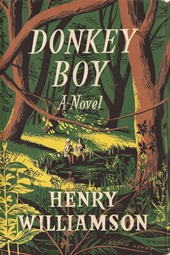 |
|
| First edition, Macdonald, 1952 | |
First published Macdonald, October 1952 (12s 6d)
Re-issued Macdonald, using first edition sheets, re-cased and with a new dust wrapper bearing an ISBN. Date not known, but probably 1970, as that is when ISBNs were introduced in the UK.
Panther, paperback, 1962 and 1970
Zenith, paperback, 1984
Reprinted Macdonald, 1984
Sutton Publishing, paperback, 1994
Currently available at Faber Finds
Donkey Boy is an evocation of time and place: of an ordinary family living in south-east London at the turn of the nineteenth/twentieth century. As the book opens we are in 1897 and at the beginning of the story of Phillip, Richard Maddison’s first born (and the central character of A Chronicle of Ancient Sunlight), now two years old and nicknamed ‘Donkey Boy’ because, due to his early problems, his life was saved when he was fed on the milk of an ass, brought to his despairing parents by ancient Mr Pooley. The book is an honest and vivid account of young childhood with all its trials and tribulations, and we truly live the lives of this fictional family with the wealth of detail of their lives and of the period.
But young Phillip is already rather a problem child in the eyes of various members of the family: he is sensitive and nervously imaginative, tending to lie his way out of trouble, whose naughty escapades – those of a normal child – are not understood by his parents. We are shown how his father’s increasing irritation and his mother’s ineffectual placatory interference combine to have an adverse effect on the child: which is of course HW’s purpose, part of his ‘cause and effect’ theme, which we have already seen in the earlier Flax of Dream series.
The book opens with Richard Maddison making a visit to the house he has just bought, 11 Hillside Road, Wakenham, which faces his beloved ‘Hill’: in real life this was 11 Eastern Road, Brockley (later re-numbered 21) opposite Hilly Fields, and which still exists today, looking more or less as it did then. This house was bought in fiction as in real life (£480 pounds in real life – slightly more in the novel) with money that came to him from his grandfather’s Trust on the death of his father. The builders have departed and Richard has the house to himself for the first time. His sense of pride is quickly deflated by the mess left behind by the workmen, but he soon clears everything up. The Crystal Palace at Sydenham can be seen from the first floor balcony, glittering in the sun in the distance: a symbolic edifice that has its own thread as the series progresses.
The house is to be called ‘Lindenheim’ (‘Hildersheim' in real life) after his mother’s home in Germany. This visit is full of hope for the future – but a hope that is almost immediately blighted, echoing the blight that attended his secret marriage in the first volume, The Dark Lantern.
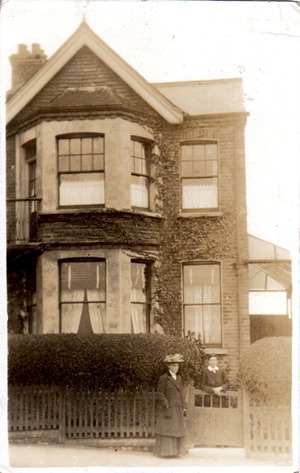 |
| 11 Eastern Road, Gertie and HW at the gate |
Richard hurries back to their rented house to collect his wife Hetty and baby Phillip for a visit planned for that afternoon, but to his great distress and anger he finds Hetty’s brother Hugh is visiting. He has forbidden any visits by Hugh, but due to his inhibitions is totally unable to explain his reason to his wife – namely that Hugh has contracted syphilis, and Richard is terrified of cross-infection, especially on behalf of his young son. He cleans everything Hugh can have touched with carbolic.
Meanwhile he discovers that young Phillip, in an excess of zeal to be like daddy, has damaged his precious collection of butterfly specimens and now has found a pair of scissors and cut up that day’s newspaper – the last straw for Richard, who smacks his bottom hard.
Later recovering, the proposed visit to the new home does take place. Hetty is again heavily pregnant and Richard informs her that he has arranged for his former nurse, his mother’s former German companion Minne (called Minnie) will be coming to help with the children. Two weeks later they move into Lindenheim. Phillip forms a great attachment to Minnie, but in due course her need for her homeland causes her to return, and Phillip is left bereft of her honest and homely affection.
The importance of ‘the Hill’ is shown throughout the story (although Richard thinks the Hill is ‘fast becoming spoiled’). On Thursday evenings it is crowded with people watching the distant Crystal Palace firework display, and on Sundays with those listening to strident speakers at the ‘Socialist Oak’ – a prominent feature of the Hill. There is a huge bonfire there to celebrate Queen Victoria’s Diamond Jubilee (22 June 1897). Richard carries young Phillip up to see the magnificent sight while he watches the chain of beacons being lit right across the south, imagining those he cannot actually see, including one at Caesar’s Camp above Folkestone – an area that meant a great deal to HW, who had previously shown its great importance for Willie Maddison in his earlier novel The Dream of Fair Women.
Richard Maddison is shown as upright (he works very hard), active in mind and body (he joins the Antiquarian Society, plays tennis, flies kites on the Hill, has cycling holidays, goes for walks with his family every Sunday); but he is hemmed in by his own inhibitions and the mores of Victorian society, and frustrated by life itself. His life becomes completely blighted by the arrival of his in-laws, Thomas and Sarah Turney, to live in the house adjoining his own (as indeed did William Leopold’s real-life in-laws), which even shares that first floor balcony. From then on he feels, with some justification, that his wife attends more to her father’s wants than to his own.
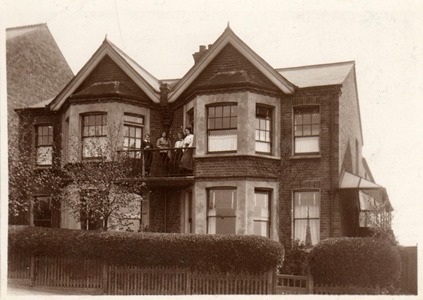 |
| 11 & 12 Eastern Road; Gertie and her children on the shared balcony |
One morning Hetty wakes up feeling very ill. She has scarlet fever, a most dangerous illness in those days, often resulting in death or debilitating weakness – and highly contagious. It is arranged that Phillip (now five) and his sister Mavis (three) will immediately go to stay with Richard’s sister, Victoria, married to George Lemon, a well-to-do solicitor, who live in Epsom. They are escorted there by the oldest sister Isabelle, a spinster and governess, conveniently between jobs. All are based on real-life counterparts.
They travel via a very crowded and noisy Waterloo Station, and we learn that the reason for this is that news has come through of the Relief of Mafeking, in South Africa (17 May 1900). Phillip wanders off and gets lost, and then, over-excited, is inevitably sick on the train; it is obvious that ‘Aunt Belle’ has no sympathy for children whatsoever (and one feels, as is intended, somewhat sorry for any children in the charge of such an unsuitable personality!).
At Epsom is also gathered another brother, Hilary Maddison, on leave from his duties as an officer on the Phasiana, a liner of the MacKarness line. (Hilary is based on HW’s uncle Henry Joseph Williamson, a purser in the Merchant Navy.) Hilary is convivial but somewhat unimaginative. He has also witnessed the Mafeking Day celebrations, so we hear more of this momentous event. We soon discover he is interested in George Lemon’s widowed sister, Beatrice, an actress who is also visiting (with two small children left in charge of a nanny at her own home), and they duly become engaged and later married. Bea is sympathetic towards the young Phillip, and helps smooth his various awkwardnesses.
An exciting event (and a further set piece description) is Derby Day – especially for Phillip who, although not allowed to go, manages to escape from the house and find his way there with the excuse of a dog belonging to an aristocratic neighbour, and so enjoys the festivities, to the chagrin of his Aunt Victoria. But they now become friendlier, and as a consequence Phillip behaves himself better.
Hetty, now recovered and having had a convalescent holiday in Brighton, arrives to collect her children, nerving herself to meet her husband’s family, most extraordinarily for the first time. Phillip typically hides and refuses to speak to his mother until Beatrice cajoles him to comply.
With a third baby on the way, and Minnie returned to Germany, Phillip and Mavis are sent to the local Dame School, a nice cameo of the prevalent system at that time.
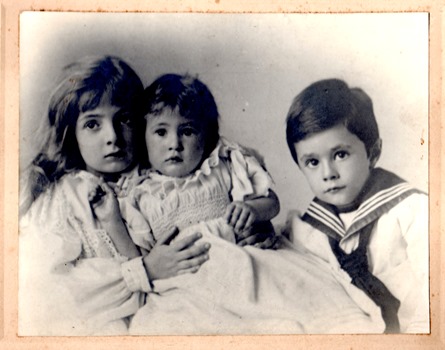 |
| Henry, Kathleen and Biddy in around 1900 |
The whole theme of education is expanded with the arrival back in Bristol from her extended six-year sojourn in Greece of Richard’s youngest sister, Theodora, once the close friend of Hetty. Theodora plans to start a school with her friend from University days, Rechenda:
based upon the truths of nature, as revealed by the great philosophers and artists of all known civilisations.
It should be noted that the quotation on the title page of this volume is from the great Swiss educationalist Johann Heinrich Pestalozzi (1746-1827):
Learning is not worth a penny when joy and courage are lost upon the way.
In the earlier Flax of Dream novels HW’s theme (theory) that education should be intuitive (as in Jean Jacques Rousseau’s theory put forward in his famous novel Emile) was openly, and possibly a little clumsily, pursued. In these early volumes of the Chronicle it is interlaced more subtly and naturally, HW being now a far more experienced and mature writer.
The two young women set out the preparations for the practicalities of their idealistic school, signing a partnership contract and a lease on a large property nearby. However, this school venture is to be short-lived for various reasons and has already closed before the end of this volume.
Meanwhile Theodora sets out to visit her family, whom she has not seen since before her departure for Greece: first to her brother John and his son Willie (so linking in the earlier series), where she is very concerned at the situation she finds. Then she goes on to London to see Richard at his new house. She walks from the station to the Hill, where she wanders for some time, noting all she sees (a useful ploy for our author to describe the area!) and her low spirits revive. But when she arrives at Lindenheim she finds Phillip (her godson, of whom she became very fond when the family had visited before she left for Greece) in tears and despair, trying to write lines, his punishment for an earlier misdemeanour. Theodora realises that there is a big problem in the family.
She learns that Thomas Turney now lives next door and is giving a family party that evening. His son Hugh has joined the City Imperial Volunteers (CIV) Mounted Infantry, together with Sidney Cakebread, and they are setting out the following day for South Africa and the Boer War. Theodora had been in love with the already married Sidney Cakebread (and had travelled to Greece to escape this situation), and this is rather a shock.
Richard has refused to attend the party (he has never forgiven his in-laws for their behaviour and insults) and goes off to fly his kite on the Hill with his friend Mr Muggeridge. There follows a lyrical description of this very pleasant pastime – interrupted by the exciting passage overhead of a balloon (chilling in retrospect – as similar vehicles were to take on sinister connotation in due course):
the sun glinting on the spheroidal grey of its serene approach.
In a good mood on his return Richard decides to join the party next door, where Thomas Turney, after much to-do and interruption and a diversion of some songs from Hugh, declaims by candlelight the Agincourt speech from Shakespeare’s Henry V.
A few months later the news comes that Sidney Cakebread had died of enteric fever (typhoid) in South Africa, leaving his wife and young children bereft. Hugh returns in due course, his disease gradually worsening and weakening him.
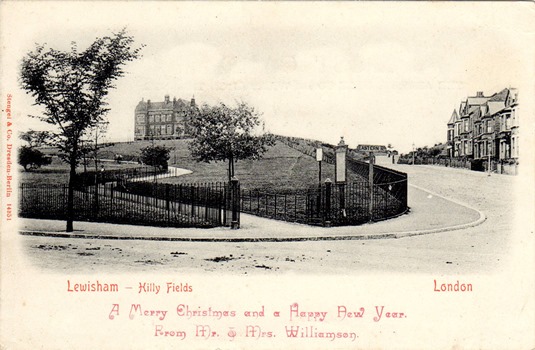 |
| A Christmas card from William and Gertrude Williamson, from around 1900 |
The mood and scene changes completely as Phillip excitedly prepares for an Easter holiday visit to his cousins at Beau Brickhill in Gaultshire – and so we are transported to the family home of the Leavers/Turneys in Aspley Guise, Bedfordshire which were so important to HW’s childhood, where we meet his cousins Charlie and Marjorie Boon in the guise of the fictional Percy and Polly Pickering. But the idyllic holiday ends in disaster. Richard has stayed at home, and when the family returns to London confirms his suspicions that Phillip had taken his very precious dark lantern, and canes the boy for his ‘sin’ and for lying about it.
Phillip is then sent to the local ‘Wakenham Road School’ (equivalent to a modern primary school) under the headmastership of Mr Alfred Garstang, ‘a figure of near-terror to Phillip’, although we can see that he is a most kindly man.
(Transport is an important thread in HW’s writing: and so we have various bicycles, motor cycles and cars woven into the various volumes of the Chronicle as time passes, reflecting a historical progress and indeed in many ways an allegorical progress within HW’s own life.)
Richard moves from a home-made kite to a splendid new one, a box kite called the Emperor Moth, which he takes on to the Hill to fly in a very strong wind (and to show it off to Mr Muggeridge) and where with great detail and much excitement and despite tying it to a seat, it breaks away and is lost: but later retrieved that evening by a couple of rough men who pour scorn on the paucity of Richard’s tip as reward! It is a wonderful scene. One of William Leopold’s kites still exists in its original box – actually a very fragile construction of tissue and thinnest bamboo struts, most beautifully constructed (see HWSJ 38, September 2002, p.42 for photograph and description) – but such a kite never turned over a solid wood park bench!
Another sign of ‘progress’ is the continual encroachment of suburbanisation on the countryside: the building of Richard’s own house is a major example (although of course he does not see it thus), and we learn further that the elm trees are cut down in the ‘Backfield’ to make way for houses to be built in their place.
The next set piece big scene is a summer holiday on Hayling Island (off the south coast of England). Starting with the train journey from Victoria station, every detail is carefully recorded (including Phillip’s train sickness). The family (sans Richard to begin with) stay at ‘Sea View Cottage’. After a day or so Richard arrives by bicycle. He plays tennis with a local colonel and wins, to Phillip’s great pride. On the beach Phillip sees the fishermen come in with a catch and proudly buys some fish with his own money, taking them back for tea. He also with great daring rushes off and has a go on the ‘Life Saving Apparatus’ (something akin to the wire slides found in adventure parks today) in full sight of the family, and again is very proud of himself. Phillip is growing up. After a day or so Richard goes off on his bicycle for a holiday in the West Country, following which Phillip seems to do just what he wants!
These holidays on Hayling Island took place over several years of HW’s childhood, and all these details are totally authentic, even down to a postcard sent to Phillip by his father. Further details can be found in Robert Walker, ‘Henry’s Hayling Holidays’ (HWSJ 46, September 2010, pp. 15-28).
On return home Phillip’s naughtiness again comes to the fore: he fires at and breaks a neighbour’s revered glasshouse, and, worst of all, sets fire to the grass in the famous backfield. There are magnificent details of the fire engine arriving to put this out – while the desperate Phillip cowers under his bed terrified and yet exulting in the scene. He also gets caught by his horrified father peeing against a lamp-post! But we also learn that Richard has his own secret shame – a book of photographs of nude women (very tastefully posed of course!), ‘The Parisian Artist’s Sketch Book of Models’, which he keeps locked in his desk and looks at when he knows he will not be disturbed.
The emphasis now shifts to Phillip at school – still in Standard Four and learning little. His form master is Mr Twine, who canes the boys vigorously, especially poor Horace Cranmer from Skerritt Road, known locally as the slum. In due course, Phillip befriends the hapless Cranmer, and takes bits of bread and dripping for the practically starving boy. Cranmer gives Phillip his total loyalty in return.
Phillip is supposedly working towards a scholarship, but is unable to learn, despite extra coaching, and gets very worked up about it all. The day of the scholarship examination is a fearful time, and he seems unable to write or answer any question until the composition paper, when he finds himself carried away writing a story about a walk by the river (actually a small brook) at Beau Brickhill (his cousins’ home where he has visited). Afterwards he finally stands up to the bully Mildenhall who has made his life a misery for some time, and finds Mildenhall is a worse coward than himself!
As the end of term approaches Phillip is looking forward to a holiday at Beau Brickhill, but is called out of class by the headmaster. Imagining that every sin he has ever committed has been discovered, he is confused to be questioned about his essay by an elderly gentleman, Sir Park Gomme, who has come to announce the names of the boys who have won a scholarship. Phillip’s composition has won him a place.
The volume ends with a paragraph about the man who had saved his life by bringing him ass’s milk when he was a sickly baby, old Mr Pooley, who had lived to be 105, as Phillip unknowingly passes by his pauper’s grave on his way home to tell his mother the good news.
*************************
The authenticity of the period details gains even more importance as time passes (one might say the ‘Proustian effect’). Research by various members of the HW Society into the area where HW grew up (Brockley and Lewisham in south-east London), his own family and his holidays with relations in Bedfordshire, and his visits to Hayling Island in the early years of the twentieth century all reveal a wealth of corroborative detail, and give fascinating insights into time and place.
It is this wealth of detail, both of the socio-historical aspect and the life of Phillip as a young child, that transports the reader deep into his world with complete empathy. We live Phillip’s life, as the author meant us to do.
*************************
Index to 'The London Trilogy':
Between 2000 and 2002 Peter Lewis, a longstanding and dedicated member of The Henry Williamson Society, researched and prepared indices of the individual books in the Chronicle of Ancient Sunlight series, with the first three volumes being indexed together as 'The London Trilogy'. Originally typed by hand, copies were given only to a select few. His index is reproduced here in a non-searchable PDF format, with his kind permission. It forms a valuable and, indeed, unique resource. The PDF is in two sections:
'The London Trilogy': An Index — Aerated Bread Company to Maddison, Theodora
'The London Trilogy': An Index — Maddison, Phillip Sidney Thomas to Zoo
*************************
Tucked inside an envelope pasted into the back of his file copy of Donkey Boy, and possibly for HW the most gratifying response to the publication of the book, was a letter that he received from Angus Wilson (it has now been removed from the book and filed), dated 19 November 1952, in which Wilson writes:
Your publisher very kindly sent to me Donkey Boy. I am a reader of long standing of your work and a particular lover of The Dream of Fair Women. I am very excited to see you breaking new ground in this way and all the details of London suburban life of the 90’s seem to me fascinating . . . I look forward to the rest of the volumes of the series immensely.
Angus Wilson (1913-1991) was still at the start of his own writing career at that point, but his recently published Hemlock and After (1952) had gained great critical attention. Wilson was currently employed as Deputy Superintendant of the Reading Room at the British Museum (which also employed George Painter, the Proust biographer, who also championed HW’s writing). Interestingly, in 1967 Wilson published his own social-history saga No Laughing Matter.
One feels that many of the following reviewers had not yet grasped the larger view of what HW was planning (understandably – today we have the hindsight of the whole opus before us and can see the roman-fleuve effect), and are reviewing a single novel which they feel had no conclusion rather than one in a series of novels which will develop the story line and characters in due course.
The Spectator (Tangye Lean), 14 November 1952:
Mr. Henry Williamson’s massive historical novel, . . . reaches its second stage in Donkey Boy . . . . With extraordinary skill and precision he rebuilds the scenery of the past – its attitudes to domestic servants, straw hats and tennis racquets – and in front of it he brings on his minor figures of the middle and lower class. We follow them with an almost morbid interest, as if we were rummaging in a trunk filled with old family letters and photographs which belong authentically to another world. . . . In this sense Mr. Williamson seems to be engaged in a thriller whose instalments can be relied on to animate a whole section of social history.
Eastern Daily Press (Adrian Bell), 25 November 1952:
Mr. Henry Williamson is an author of two moods – of nature and human nature. The quiet art of his human studies is nowhere more evident than in his new book, Donkey Boy. How well he builds up a scene; a suburban interior, a family party. We are given a true-to-life picture of the married life and relations of Richard Maddison. Richard’s son, called the Donkey Boy, is the central theme from babyhood to school days. A lively boy, an imperious father, a timid doting mother; these provide a story of conflicting wills, and through them the boy’s discovery of life. For background there is the South African War, Mafeking Day, the Diamond Jubilee. Mr. Williamson’s art of character-drawing is so complete in itself that it tends to hamper the movement of his story. The tale becomes the picture, but so good a one that the reader is content to have it so. Despite the naughty adventurous youngster, it is as a period picture, a conversation piece of the nineties, that Donkey Boy to me chiefly lives.
John O’London’s Weekly (Pamela Hansford Johnson – wife of C. P. Snow), 31 October 1952:
BOY IN EDWARDIAN LONDON
Mr. Henry Williamson is a serious and honourable novelist, regarded by many critics with the highest possible esteem. He has the sense of unhurried narrative common to the great Victorians, and the psychological penetration demanded by a later age. What he lacks is what the Romans called the furor poeticus – the “poetic rage” [HW has underlined this in red with several ???? in the margin!] that Dickens, Dostoevski and the Bröntes had, George Eliot, Thackeray and Trollope had not. . . .
Donkey Boy . . . is the study of a little boy who feels himself unregarded by a beloved father, and to attract his attention falls into a series of tragic mischiefs that finally begin to look almost like juvenile delinquency.
Against the background of London at the beginning of the century, a background beautifully, elaborately yet somehow quite effortlessly painted. Having the tang of the times, its stuffiness, its colour and its curious nearness, the history of this lost child unrolls itself strongly and touchingly. . . . Mr. Williamson would not be the artist he is if he had not left Phillip with the discovery that joy is possible, that joy and courage are possible, and that both may be his after all.
The method of story-telling is rather opaque, the scenes crowded too closely one upon another to permit the emergence of that light and shade which is the essence of poetry; but Donkey Boy is a fine novel in its own rather stolid way, and a satisfying one.
New Statesman (Anthony Curtis), 8 November 1952:
Donkey Boy, by contrast [to The Strange Children by Caroline Gordon, subject of preceding review] is heavily obsolete . . . has a child at [its] centre. . . . We watch Phillip’s development up to the beginning of the reign of Edward VII when he wins a scholarship to a senior school. . . . Mr. Williamson is not exclusively concerned with the suffering of the very young. His larger intention becomes plain when, after a very few pages, one realises he is opening a huge haphazard historical bazaar. The Maddison family to whom he has again returned are the pretext for the Diamond Jubilee, Mafeking Day, Kipling, Mr. Belloc, and the rest of that crowded period. Not only does Mr. Williamson knowledgeably retail the big events, but also the most minute details. . . . [but] by the end of four hundred pages I found myself bitterly resenting having had the mind cluttered up with so much pointless bric-a-brac.
Of the innumerable characters . . . only one quickened interest – Theodora, the young blue stocking who tried with a friend to set up a progressive school. But she, like the rest, is brought to no real conclusion. What, basically, is so unsatisfying about Mr. Williamson’s vast enterprise is his major failure to create development, to manage an essential plot, in contrast to the steady plodding march of time which he handles with energetic assiduousness.
Time and Tide (Fred Urquhart), 1 November 1952:
The sequel to The Dark Lantern . . . The result is a multi-coloured portrait, vibrant with light and shade. Mr. Williamson’s study of a sensitive child, yearning for love and understanding, is a masterly piece of work. The background of London suburban life in the late nineteenth and early twentieth centuries is beautifully worked in, and the scenes of small Phillip being lost in Waterloo Station on Mafeking Day, his stolen trip to the Derby, and his grandfather’s reading from Henry V to the assembled family on the night two of his uncles depart for the Boer War will remain in the memory.
Daily Telegraph (John Betjeman), 31 October 1952:
“THE DONKEY BOY” by Henry Williamson is the story of an odd little boy growing up in a London suburb at the beginning of this century. Phillip’s father, Richard Maddison, belongs to a family who have “come down in the world” . . .
Phillip is a puny, imaginative child: he grows up nervous and naughty, and is always telling lies . . .
The book is full of atmosphere and imaginative reconstruction of a period. The observation and the sensitive approach to the characters and their surroundings are the best part of the book. On the whole it tries to do too much and lacks composition. It tries to depict a period, to tell the story of Phillip, his father and all his family, and also to be a “psychological” study of a difficult child. Phillip should have remained the centre of the story. As it is, the thread of the narrative is constantly getting lost, and one’s attention is divided.
The Times Literary Supplement (unsigned), 31 October 1952:
Donkey Boy is the second volume in a series of “period” novels about a dullish pillar of lower-middle-class society named Richard Maddison and his more interesting family. [The reviewer then objects to some of the ‘period’ details given, e.g. the cost of bread etc] . . . This is the more regrettable because Mr. Williamson has an excellent story to tell about the difficult childhood of Richard’s son Phillip, and tells it at times very movingly. Phillip is an odd, imaginative child who suffers almost equally through the smug insensitiveness of his father and the eager protectiveness of his mother. The story of his life . . . has a veracity which needs no artificial enhancement.
Shields Gazette (unsigned), 4 November 1952:
Mr. Williamson . . . is a shrewd observer of the family scene . . . and as his earlier tetralogy The Flax of Dream showed, he has a deep understanding of the child outlook.
Donkey Boy brings us once again into . . . that family of unfortunate parents and misunderstood children. . . . Mr. Williamson reviews the [historical] vista against the tension of this family background . . . . It is a skilful and penetrating picture and if there is an echo of disillusionment it serves only to etch the colours more sharply.
Mr. Williamson is rich in sympathy for his fellow creatures as one realised from listening to him reading from his own works some years ago. It is an absorbing novel. Its prose is clear, restrained and unforced. It well deserves to join the Flax of Dream on the Williamson bookshelf.
Illustrated London News (unsigned), 16 November 1952:
Sequels are nearly always, in some measure, disappointments . . . [so thus – inevitably – is Donkey Boy. The reviewer takes us first through “The Dark Lantern” – a sad book – where nature is eaten up by the ‘Great Wen’ (a euphemism for London): which theme is continued in the present volume.]
. . . That is what Richard sees. What we see is the making of a problem child. . . . This private drama is a mirror of the late-Victorian background; it is what comes of thwarting nature. Richard, himself unhappy and repressed, must needs be a conductor of repression. In the deepest sense, it is a true story; the age is wonderfully drawn, the spirit large. But the effect is rather lowering and painful.
Oxford Mail (unsigned but probably – almost certainly! – S. P. B.Mais), 23 October 1952:
One thing about Mr. Henry Williamson stands out a mile. That is his integrity. He is dead honest. This great virtue has its limitations . . . Mr. Williamson moves at so leisurely a pace . . . that the story scarcely seems to move at all. [and has too much ‘ning-a-ning man etc’] We expect and usually get explicitness from Williamson. His power of observation, like his memory, is quite remarkable, and he certainly recovers and communicates the atmosphere of those carefree Mafeking days brilliantly. Such story as there is could scarcely be simpler. [There follows a résumé of the plot.]
Whether this novel will advance Williamson’s deservedly high reputation I cannot say. For myself I preferred . . . “The Dark Lantern” . . . . Having said all this, let me assure you that if you have patience you will find that this book adds up to something, which is more than can be said of 99 per cent of the novels that come my way.
The Irish Times (B.W.), 8 November 1952:
“Donkey Boy” is a spacious and atmospheric chronicle . . . . Young Phillip Maddison – cousin of the hero of Mr. Williamson’s famous series of novels “The Dream of Fair Women” [sic] – has the misfortune to belong to a father who has seen better days. He is a neurotic little boy . . . The book is a successful pageant of the time in which it is set and Phillip is a plausible creation.
Manchester Guardian (Paul Bloomfield), 31 October 1952:
I must confess that the literalness of this book about a little boy groping his way into life in late Victorian Kent has not much appeal for me. There is a freedom from mannerism which I admire – but Mr. Williamson hardly needs my puff, so let us move on.
North Devon Journal (F.H.K.), 16 October 1952:
CHILD OF THE NINETIES – Henry Williamson’s New Novel
. . .”Donkey Boy” describes in a wealth of detail how a nervous and undeveloped infant suffers under the duress of stern Victorian parenthood and its relentless dogma of “spare the rod and spoil the child”. . . .
. . . Mr. Williamson has executed his usual feat of brilliant descriptive writing. By using a style that is at times almost formal enough to be pedantic, he creates a convincing atmosphere of the slow-dying Victorian era. . . .
There are times when one feels that the author is cutting at the hypocrisy that still lingers, not entirely obliterated by the upheaval of two Armageddons, but this is a book that will be remembered mainly for its clear and rational examination of children’s actions, invariably revealed through the eyes and mind of a child.
Sydney Morning Herald, Australia (Russel Ward), 24 January 1953 (24 column inches):
Magic World of Childhood
Discerning readers often feel a measure of reserve, or even apprehension, when a novel is recommended as poetic. Too often this means that the writer has failed to subject his emotions to the digestive process which can transform them into a work of art.
“Donkey Boy” is poetic in quite another sense. It is a journey into the magic world of childhood. . . .[There follows a plot analysis, with extensive quotes, & analogies to modern life – e.g. election propaganda techniques.]
However, the real criterion of a novelist’s stature is not, after all, his ability to paint the background of a place or period accurately, but his power of characterisation. In this, Henry Williamson can have few equals among living writers. The Maddison family, their friends and relations, are so good that one feels one would recognise them in medieval Lapland or modern Lakemba.
Mombasa Times, Kenya, 14 March 1953:
Henry Williamson’s most famous book must be “Tarka the Otter”. In that he revealed an almost uncanny knowledge of small creatures. Now he writes the story of a little boy and he has obviously studied the mind and reactions of a child with the same sympathetic understanding that made Tarka so real a creature. [There follows a résumé of the plot and ends with reference to the Pestalozzi quotation.]
Punch, 16 November 1952:
Donkey Boy continues the history of that unattractive, essentially pathetic, prig hero of “The Dark Lantern”, but chiefly concerned with his small son. Few better descriptions of an imaginative, selfish, sickly small boy, unlucky in one parent, have been written. Phillip is a nasty child, but the reader knows why. Some inessential ugliness could be spared.
The Scotsman, Edinburgh (unsigned), 27 November 1952:
In Donkey Boy Henry Williamson continues the series . . . Mr. Williamson is at his best when describing this boy’s pursuits and longings, his reaction to life at home and at school. . . .
Liverpool Daily Post (D.S.), 3 December 1952:
It is more than the [usual socio-historical] account . . . it is also a study of the difficult relations between Richard Maddison and his small son Phillip . . . [without the benefits of modern child psychology, which anyway appears to have made no difference to the modern ‘little monster’] .
It is slow moving at first and there is too much baby talk anyhow for the male reader but it quickens . . . and there are vivid descriptions of country sights and sounds which one was hoping for in a book by the author of the great “Tarka the Otter”.
Paisley Gazette (unsigned), 8 November 1952:
[General preliminary remarks] . . . This is essentially a story of a family, almost indeed, biographical in its detail and insight into the thoughts and feelings, ways and habits of the various members . . .
Balance, sincerity, and a genius for that magic descriptive turn which converts a comparatively simple story into a perfect interpretation of a life and period which . . . lift this book into the quiet galleries where are gathered those novels which through the years have become hailed as “literature”.
Clapham Observer, and also in the Balham News and Mitcham News, 14 November 1952 (Included for its wonderful ‘local’ approach!):
The prominence of the old Crystal Palace in the lives of ordinary people at the turn of the century is clearly seen in . . .”Donkey Boy”. With its setting in the “Crystal Palace country” the book describes many major events at the Palace. . . .
Tablet, 27 December 1952:
Donkey Boy [words to the effect that one really needs to have read vol. 1] to quite comprehend the background of Richard Maddison, a poorly paid clerk in an insurance office, but descended on the one side from more or less “County” people, and on the other from German nobility. However the character of this austere wage-slave comes through quite clearly: his pride in having bought his own little house in the suburbs: his resolution to save and starve for the future benefit of his children: and his total inability to make himself agreeable and forebearing to them and his loving little wife. . . .
The Birmingham Post (R.C. Churchill), 28 October 1952:
In Donkey Boy Mr. Henry Williamson is partly, I suspect, autobiographical . . . set at the turn of the century, the novel recreates with great skill the London suburbs of the H. G. Wells era, and against this background is played a domestic drama, ordinary enough perhaps but invested with considerable individuality in the telling. This is one of the most interesting novels the author has written.
The Bulletin, Glasgow (T.G.H.), 6 December 1952:
NOVELS OF THE 19TH CENTURY
Three eminently readable novels by three notable authors have been my good fortune this week and, though they range from England to America and Australia, they have a common denomination – the ways of the nineteenth century. [The other two are John Steinbeck, East of Eden and Martin Boyd, The Cardboard Crown.]
Life in a more conventional pattern is presented in Henry Williamson’s DONKEY BOY and those who like leisurely family reading with not too much happening, will browse contentedly through the suburban London world of Phillip Maddison as he grows from babyhood to boyhood.
*************************
The dust wrapper of the first edition, Macdonald, 1952, designed by James Broom Lynne:
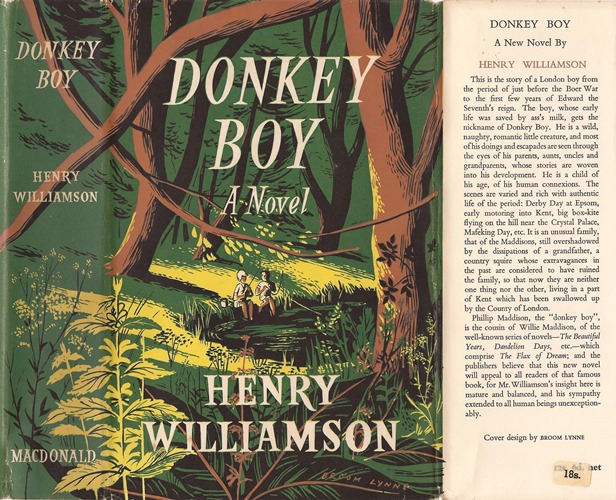
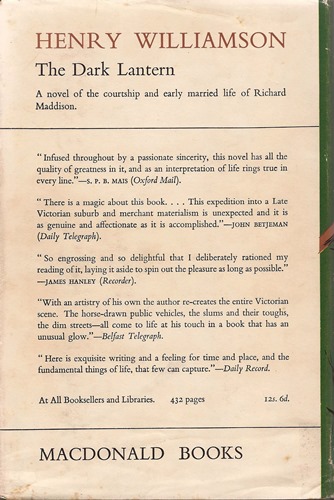
Macdonald re-issued the book at a later unknown date, using spare sheets from the first edition: the year of publication on the reverse of the title page still being given as 1952. This is clearly not the case, however, as it was published with a new, not particularly attractive, dust wrapper which bears an ISBN (International Standard Book Number). These were only introduced in the UK in 1970, so this, or soon after, is the probable date of publication. The Golden Virgin was also re-issued at the same time, and given a similar jacket.
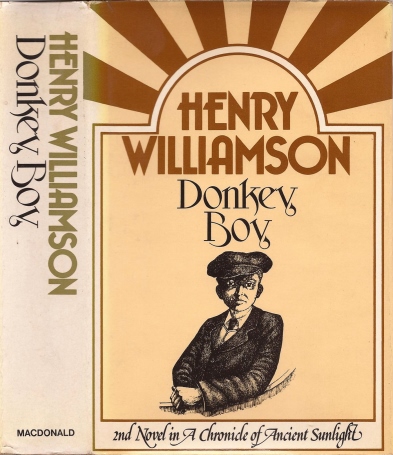
Other editions:
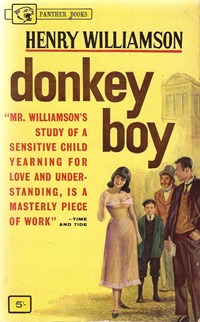 |
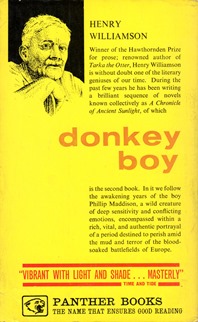 |
|
| Panther, paperback, 1962; and back cover | ||
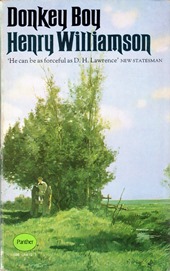 |
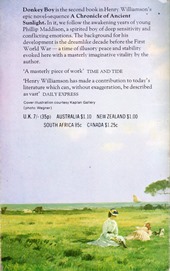 |
|
| Panther, paperback, 1970; and back cover | ||
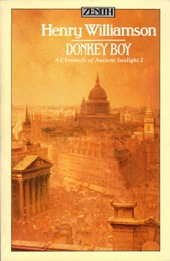 |
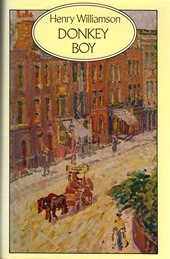 |
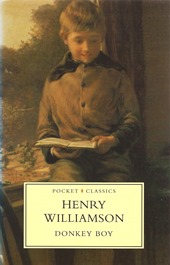 |
||
| Zenith, paperback, 1984 | Macdonald, hardback, 1984 | Sutton, paperback, 1994 |
Back to 'A Life's Work' Back to 'The Dark Lantern' Forward to 'Young Phillip Maddison'
